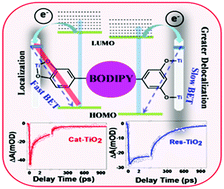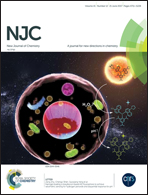Demonstrating the role of anchoring functionality in interfacial electron transfer dynamics in the newly synthesized BODIPY–TiO2 nanostructure composite†
Abstract
New BODIPY derivatives (dyes 1 and 2) with either catechol or resorcinol functionality, respectively, for anchoring to nanostructured (NS) TiO2 surfaces were synthesized. Extended conjugation at one of the two pyrrole rings at the C3 position helped us to achieve the desired control in tuning the optical and redox properties of the BODIPY based dye molecules. Relative emission quantum yields (Φem1 = ∼52 ± 2% and Φem2 = 54 ± 2%) were found to be much higher in a polar aprotic solvent (acetonitrile) and substantially lower for dye 1 in a polar protic solvent. Steady state optical absorption studies revealed the formation of a strong charge transfer complex between dye 1 and NS-TiO2, while this interaction was much weaker for dye 2. Transient absorption studies were carried out for 1/NS-TiO2 and 2/NS-TiO2 systems following excitation with a laser source of 400 nm to understand the charge transfer dynamics. The results of the transient absorption spectral studies helped us to elucidate the role of anchoring functionality in influencing the dynamics of interfacial electron transfer and charge recombination processes on an ultrafast timescale.



 Please wait while we load your content...
Please wait while we load your content...